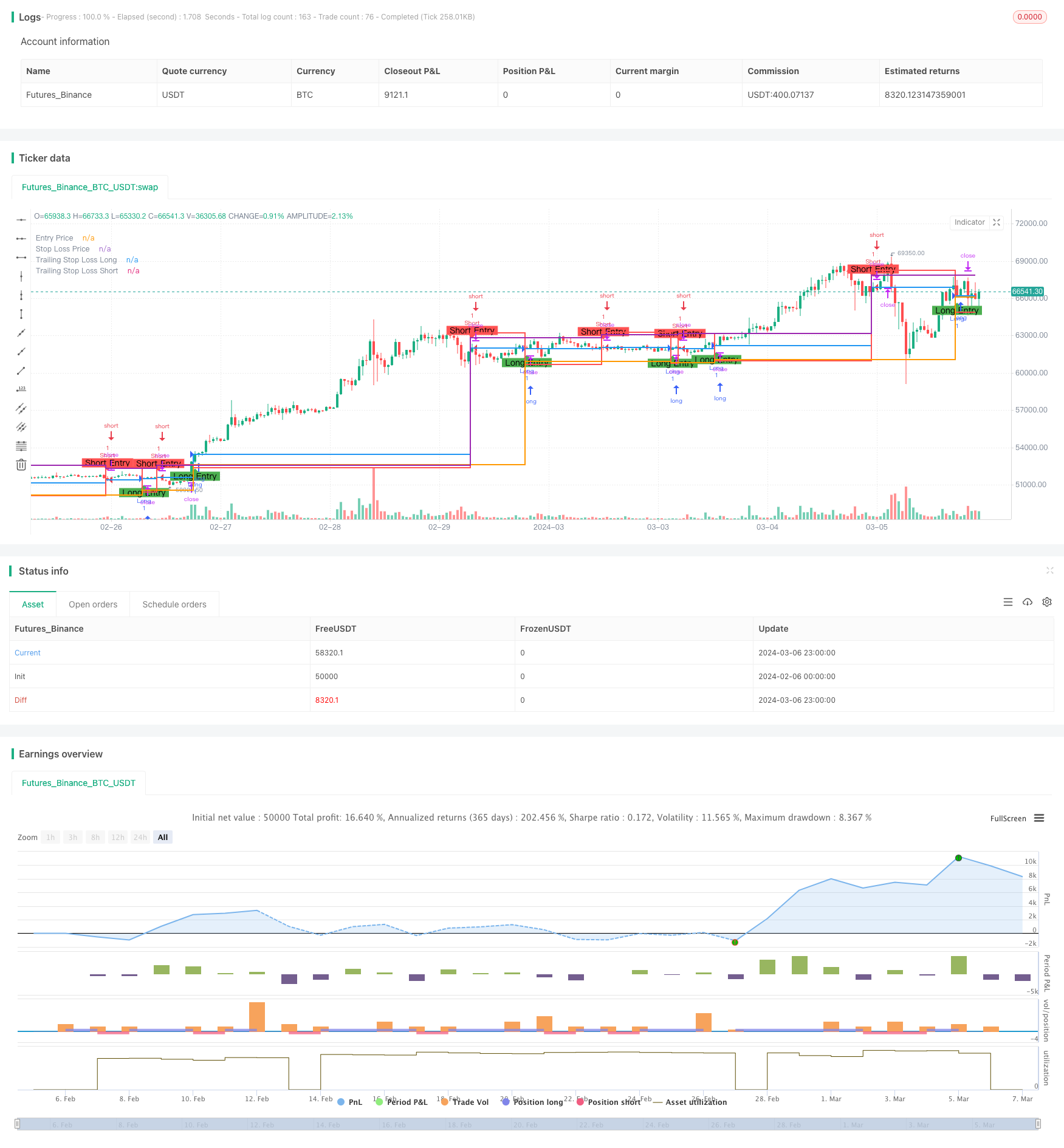
概述
动态自适应趋势交易策略是一种创新的交易方法,它能够根据实时市场数据动态调整策略参数,以适应不断变化的市场环境。与传统的固定规则策略不同,该策略采用灵活的框架,根据当前市场状况如波动率、趋势和价格走势等因素实时优化交易决策。通过融入动态元素,该策略能更有效地把握新兴机会,控制交易风险。
策略原理
该策略的核心是利用先进的技术分析和机器学习算法,实时分析市场数据,动态调整策略参数。具体来说,该策略采用以下步骤:
计算两条不同周期的简单移动平均线(SMA),分别为10日和20日SMA。当10日SMA上穿20日SMA时,产生做多信号;当10日SMA下穿20日SMA时,产生做空信号。
根据用户设定的止损百分比参数,计算止损价格。对于做多交易,止损价格为开仓价格乘以(1-止损百分比);对于做空交易,止损价格为开仓价格乘以(1+止损百分比)。
当做多或做空信号出现时,策略会开仓并设置相应的止损价格。如果价格触及止损价格,策略会平仓以控制风险。
策略还引入了动态追踪止损机制。对于做多交易,追踪止损价格为最高价乘以(1-止损百分比);对于做空交易,追踪止损价格为最低价乘以(1+止损百分比)。当价格回撤触及追踪止损价格时,策略会平仓以锁定利润。
通过动态调整止损和追踪止损价格,该策略能够适应市场变化,在趋势形成时持仓获利,同时在价格回撤时及时平仓控制风险。这种灵活的交易框架使得该策略能够在多变的市场环境中表现出色。
优势分析
动态自适应趋势交易策略具有以下优势:
适应性强:通过动态调整策略参数,该策略能够适应不同的市场状况,捕捉趋势性机会,同时控制风险。
风险管理优化:引入动态止损和追踪止损机制,使得该策略能够在趋势形成时持仓获利,同时在价格回撤时及时平仓,有效控制潜在损失。
技术分析和机器学习的结合:该策略利用先进的技术分析指标和机器学习算法,从海量的历史数据中挖掘有价值的交易信号,提高了策略的可靠性和稳定性。
易于实现和优化:该策略逻辑清晰,代码简洁,易于在各种交易平台上实现和回测。同时,策略参数可以根据市场特点和个人偏好进行灵活调整,以优化策略表现。
风险分析
尽管动态自适应趋势交易策略具有诸多优势,但仍存在一定的风险:
参数敏感性:该策略的表现在一定程度上取决于参数设置,如止损百分比、移动平均线周期等。不恰当的参数选择可能导致策略表现不佳。
市场风险:该策略主要适用于趋势性市场,在震荡或波动较大的市场环境下,频繁的交易信号可能导致过多的交易成本和潜在损失。
历史数据局限性:该策略基于历史数据进行优化和回测,然而过去的市场表现并不能完全保证未来的结果。策略在实际应用中可能面临未知的风险和挑战。
为了应对这些风险,交易者可以采取以下措施:
进行充分的参数优化和敏感性分析,选择适合当前市场环境的参数组合。
结合其他技术指标和基本面分析,对交易信号进行二次确认,以提高策略的可靠性。
设置适当的风险控制措施,如仓位管理、总体止损等,以限制潜在损失。
定期评估和调整策略,根据市场变化和策略表现及时优化和改进。
优化方向
为了进一步提升动态自适应趋势交易策略的性能,可以考虑以下优化方向:
引入更多的技术指标:除了简单移动平均线外,可以结合其他技术指标如布林带、MACD、RSI等,以生成更可靠的交易信号。多指标的结合能够提供更全面的市场信息,提高策略的稳健性。
优化参数选择:对于移动平均线周期、止损百分比等关键参数,可以通过历史数据回测和优化算法,如网格搜索、遗传算法等,寻找最优的参数组合。定期评估和调整参数设置,以适应市场变化。
加入市场情绪分析:引入市场情绪指标,如恐慌指数(VIX)、看跌期权比率(PCR)等,以评估市场情绪和风险偏好。在极端情绪状态下,如过度乐观或悲观,策略可以相应地调整仓位和风险敞口。
融入机器学习模型:利用机器学习算法,如支持向量机(SVM)、随机森林等,对技术指标和市场数据进行建模和预测。通过训练历史数据,机器学习模型能够自动发现复杂的交易模式,生成更精准的交易信号。
考虑多市场和多资产配置:将该策略扩展到多个市场和资产类别,如股票、期货、外汇等,以分散风险和捕捉更多的交易机会。通过合理的资产配置和风险管理,可以提高策略的稳定性和收益潜力。
总结
动态自适应趋势交易策略是一种创新的量化交易方法,通过动态调整策略参数,适应不断变化的市场环境。该策略利用简单移动平均线的交叉信号来识别趋势,同时引入动态止损和追踪止损机制,以控制风险并锁定利润。策略的优势在于其适应性强、风险管理优化、技术分析和机器学习的结合,以及易于实现和优化。然而,该策略也存在一定的风险,如参数敏感性、市场风险和历史数据局限性等。为了应对这些风险,交易者可以进行参数优化、结合其他分析方法、设置适当的风险控制措施,并定期评估和调整策略。
未来,该策略可以通过引入更多技术指标、优化参数选择、加入市场情绪分析、融入机器学习模型,以及考虑多市场和多资产配置等方式进行优化和改进。这些优化方向有助于提高策略的稳健性、适应性和收益潜力,使其在动态变化的金融市场中保持长期竞争力。
总之,动态自适应趋势交易策略为量化交易领域提供了一种灵活而强大的工具。通过不断优化和创新,该策略有望在未来的量化投资实践中发挥更大的作用,为投资者带来稳定而可观的回报。
/*backtest
start: 2024-02-06 00:00:00
end: 2024-03-07 00:00:00
period: 1h
basePeriod: 15m
exchanges: [{"eid":"Futures_Binance","currency":"BTC_USDT"}]
*/
//@version=5
strategy("EfficiVision Trader Strategy", overlay=true)
// Input parameters
longCondition = ta.crossover(ta.sma(close, 10), ta.sma(close, 20))
shortCondition = ta.crossunder(ta.sma(close, 10), ta.sma(close, 20))
stopLossPerc = input(2.0, title="Stop Loss Percentage")
var float entryPrice = na
var float stopLossPrice = na
// Calculate stop loss
if (longCondition)
entryPrice := close
stopLossPrice := close * (1 - stopLossPerc / 100)
if (shortCondition)
entryPrice := close
stopLossPrice := close * (1 + stopLossPerc / 100)
// Strategy entry and exit conditions
if (longCondition)
strategy.entry("Long", strategy.long)
if (shortCondition)
strategy.entry("Short", strategy.short)
// Dynamic stop-loss exit
strategy.exit("Exit Long", "Long", stop=stopLossPrice)
strategy.exit("Exit Short", "Short", stop=stopLossPrice)
// Plot entry and stop-loss levels on the chart
plotshape(series=longCondition, location=location.belowbar, color=color.green, style=shape.labelup, text="Long Entry")
plotshape(series=shortCondition, location=location.abovebar, color=color.red, style=shape.labeldown, text="Short Entry")
plot(entryPrice, color=color.blue, style=plot.style_stepline, linewidth=2, title="Entry Price")
plot(stopLossPrice, color=color.red, style=plot.style_stepline, linewidth=2, title="Stop Loss Price")
// New features
// Add a trailing stop loss for long trades
var float trailingStopLossLong = na
if (longCondition and not na(entryPrice))
trailingStopLossLong := high * (1 - stopLossPerc / 100)
// Add a trailing stop loss for short trades
var float trailingStopLossShort = na
if (shortCondition and not na(entryPrice))
trailingStopLossShort := low * (1 + stopLossPerc / 100)
// Exit long trade when trailing stop loss is triggered
if (trailingStopLossLong < close)
strategy.close("Exit Long Trailing", "Long")
// Exit short trade when trailing stop loss is triggered
if (trailingStopLossShort > close)
strategy.close("Exit Short Trailing", "Short")
// Plot trailing stop loss levels on the chart
plot(trailingStopLossLong, color=color.orange, style=plot.style_stepline, linewidth=2, title="Trailing Stop Loss Long")
plot(trailingStopLossShort, color=color.purple, style=plot.style_stepline, linewidth=2, title="Trailing Stop Loss Short")